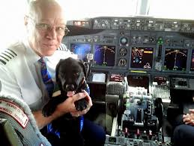 There is an aviation old joke that in the future the airplane will have a crew of two, a pilot and a dog. The pilot to feed the dog and the dog to bite the pilot if he tries to touch anything.
There is an aviation old joke that in the future the airplane will have a crew of two, a pilot and a dog. The pilot to feed the dog and the dog to bite the pilot if he tries to touch anything.
I started this article after reading about United Airlines plan to bring in all 12,000 of its pilots for additional training outside of their normal training schedule. This was being done as a result of several incidents that raised concerns about pilot response to failures.
At the airport in Seattle there have been a couple of cases where pilots landed on taxi-ways instead of runways. Besides the obvious danger to the plane and passengers in the air there was also risk to any other airplanes transiting on the ground and to ground vehicles. And the question of how could they confuse a taxi-way with a runway
 Much is being made of the inability of flight crews to respond to emergencies and take over manual flight of the airplanes they are flying. I bolded flying as there is much discussion as to the role of the flight crew, the adequacy of training and the ability to respond to emergencies or even understand what they have programmed the airplane to do, for an example see Asiana Flight 214.
Much is being made of the inability of flight crews to respond to emergencies and take over manual flight of the airplanes they are flying. I bolded flying as there is much discussion as to the role of the flight crew, the adequacy of training and the ability to respond to emergencies or even understand what they have programmed the airplane to do, for an example see Asiana Flight 214.
When you think of the tools we use to identify risks and identify potential failures (FMEAs, FTAs) do we do enough to consider how the flight crew will respond? In the medical device industry one of the concerns is alarm exhaustion, the users just don’t hear and respond after so many alarms going off. This is a challenge addressed by human factors professionals who work to identify and provide the user with the information they need to respond properly. The same if true for the pilots, what information do they need to respond to the problem and where to display it or when to provide an alarm.
The check list came into common use in aviation after a crash of a Boeing 299 (precursor of the B-17). The pilot had failed to remove an elevator pin, and the investigators realized the airplanes were reaching the point where they were too complicated for the crew to remember everything they had to do and a checklist could lessen the load.
The challenge today is not just complicated systems, but automated systems and understanding and addressing the interaction between crew and the systems. Is training sufficient to overcome the risk, do we need to expand the roles of the crew during a flight? Or do we need to move to totally automated, non-crew airplanes? These questions will be addressed as we move forward and will also be an issue as we move into driverless cars/trucks.
Bio:
Paul Kostek is a Principal of Air Direct Solutions LLC a Seattle based systems engineering and project management firm.